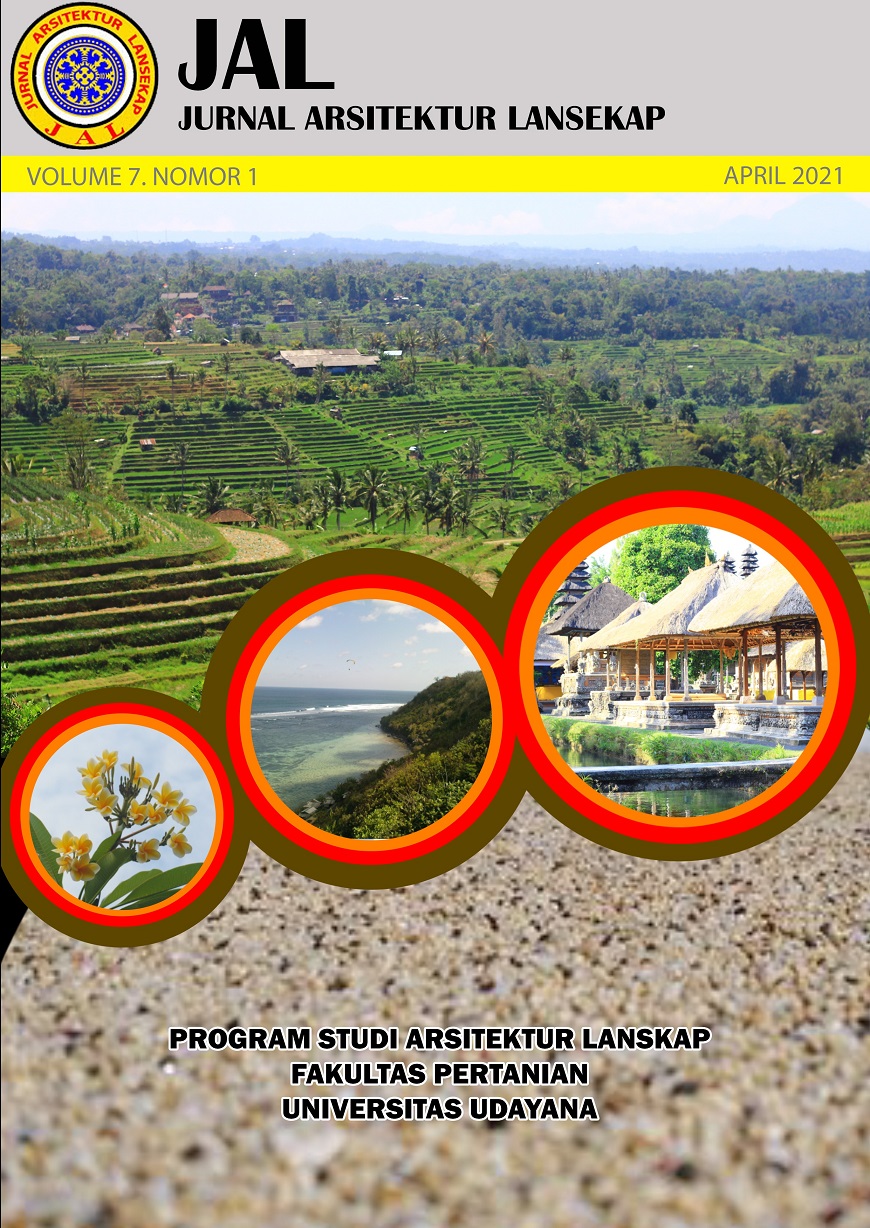Studi potensi lanskap wisata Kampung Rawa Gede, Desa Tugu Utara, Kabupaten Bogor, berbasis partisipatif
Abstract
Rawa Gede Hamlet is located in Tugu Utara Village, Bogor Regency, and nearby Mount Gede Pangrango. Beautiful sceneries of tea plantations and horticulture fields exist with various natural features such as waterfall and spring lake. However, a community business which manage coffee plantation awarded as the best national coffee called Cibulao Coffee also existed and give economical value to the local people. Therefore, Rawa Gede Hamlet has a potential to be developed as a tourism destination. The aim of this sudy is to assess how potentials Rawa Gede Hamlet as a tourism hamlet including both spatial and nonspatial aspects. In addition, the process of the study was a combination of qualitative and quantitative methods by using suitability scoring, community mapping, interview, and focus group discussion. This study also drove participatory approach as a core of research for design. The result showed that there are several tourism destination that had higher points than other according to tourism suitability. Those objects were Telaga Saat, Bukit Gerindra, Wisata Alam Gunung Luhur, Wisata Alam Gunung Kencana, dan Curug Sawer. Furthermore, this study was emerged also with non-spatial aspects and those acted as an identity of Rawa Gede Hamlet.
Downloads
References
Archer, D., Luansang, C., & Boomahathanakorn, S. 2012. Facilitating communitymapping and planning for citywide upgrading: The role of communityarchitects. Environment & Urbanization 24(1):115–129. https://doi.org/10.1177/0956247812437132.
Creswell, J.W., & Creswell, J. D. 2018. Research Design: Qualitative, Quantitative, and Mixed Methods Approaches. SAGE.
Deming, M. E., & Swaffield, S. 2011. Landscape Architecture Research, Inquiry, Strategy, Design. John Wiley & Sons, Inc.
GGNP & ITTO. 2014. Developing and Adopting an Integrated Strategic Management Plan For Cibodas Biosphere Reserve. ITTO Project TFL-PD 019/10 Rev. 2 (M), Bogor: ITTO.
Hamzah. 2020. Kopi Cibulao, Produk Kopi Robusta dan Arabica Hasil Karya Anak Bangsa. Available online at: https://gomuslim.co.id/ (diakses pada 28 Desember 2020).
Hennink, M. M. 2014. Focus Group Discussions, Understanding Qualitative Research. Oxford University Press.
Kienberger, S. 2014. Mapping environmental risks – Quantitative and Spatialmodeling Approaches. Journal of Maps 10(2):269–275. https://doi.org/10.1080/17445647.2014.891265.
LPPM IPB. 2017. Laporan Kegiatan Stasiun Lapang Agribisnis, Desa Tugu Utara, Kecamatan Cisarua, Kabupaten Bogor. LPPM IPB
Maharani, R. 2009. Studi Potensi Lahan Pedesaan Untuk Pengembangan Agrowisata Berbasis Masyarakat di Kecamatan Cigombong, Kabupaten Bogor. Skripsi. Bogor: Fakultas Pertanian, Institut Pertanian Bogor
Padawangi, R., Turpin, E., Herlily, Prescott, M. F., Lee, I., & Shepherd, A. 2016. Mapping an Alternative Community River: The Case of the Ciliwung. Sustainable Cities and Society 20:147–157. http://dx.doi.org/10.1016/j.scs.2015.09.001.
Redaksi Kilasberita. 2020. Dibalik Cerita KTH Kampung Cibulao Puncak, Raih Penghargaan Predikat Kopi Robusta No 1. Available online at: https://kilasberita.id/ (diakses pada 28 Desember 2020).
Redaksi mediabogor. 2019. Mengenal Kampung Cibulao, Penghasil Kopi Robusta dan Arabica Dari Bogor. Available online at: https://mediabogor.id/ (diakses pada 28 Desember 2020).
Smith, V. L. 1989. Hosts and guests: The Anthropology of Tourism. University of Pennsylvania Press.
Van den Brink, A., Bruns, D., Tobi, H., & Bell, S. 2017. Research in Landscape Architecture: Methods and Methodology. Routledge.
Veriasa, T.O., Rustiadi, E., & Kinseng, R.A. 2020. The Impact of Joint Community Forest Management (PHBM) on Local Community Income in Upstream of Ciliwung Watershed, Bogor Regency-Indonesia. The 6th International Conference of Jabodetabek Study Forum, IOP Conf. Series: Earth and Environmental Science 665:1-12.
An author who publishes in the Jurnal Arsitektur Lansekap (JAL) agrees to the following terms:
- Author retains the copyright and grants the journal the right of first publication of the work simultaneously licensed under the Creative Commons Attribution-ShareAlike 4.0 License that allows others to share the work with an acknowledgement of the work's authorship and initial publication in this journal
- Author is able to enter into separate, additional contractual arrangements for the non-exclusive distribution of the journal's published version of the work (e.g., post it to an institutional repository or publish it in a book) with the acknowledgement of its initial publication in this journal.
- Author is permitted and encouraged to post his/her work online (e.g., in institutional repositories or on their website) prior to and during the submission process, as it can lead to productive exchanges, as well as earlier and greater citation of the published work (See The Effect of Open Access).
Read more about the Creative Commons Attribution-ShareAlike 4.0 Licence here: https://creativecommons.org/licenses/by-sa/4.0/.







